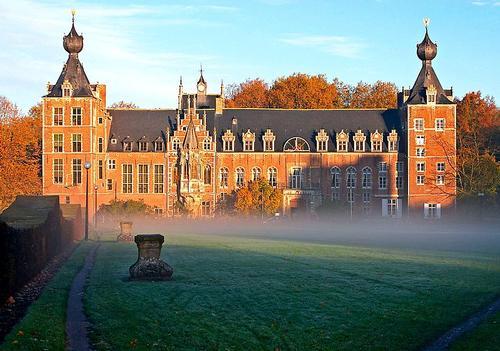BELGIUM
Society

Society
Cities in BELGIUM
| Antwerp | Bruges | Brussels |
| Ghent |
Society
General
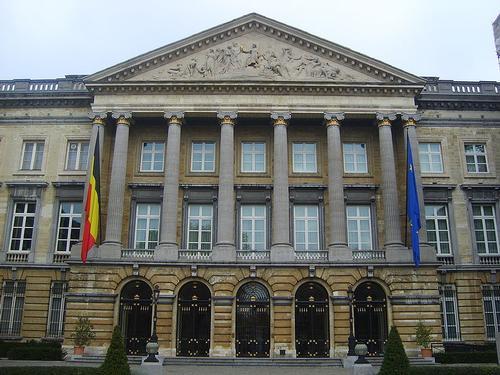
The Belgian polity is very complex. A 172 year old walks through Belgium dividing line between a Germanic and a Latin culture, which divides the country into a Dutch-speaking and a French-speaking area. A lack of national unity and increasing frictions and conflicts between French and Dutch speakers eventually led to a thorough administrative reform that started in the 1970s.
The Federal State of Belgium was founded in 1995 under the leadership of Prime Minister Luc Dehaene. There are now three equal levels in the unitary state. First, the Federal State, then the three Communities and the three Regions. These three levels of government have equal legal status with regard to legislative and executive powers. Below that, the provinces and municipalities will serve as administrative layers.
Federal state
Within the Federal State, legislative power is exercised by, on the one hand, the Federal Parliament, which is composed of two assemblies (the Chamber of Representatives and the Senate) and, on the other, the government, in particular the King and the Ministers. The king does not exercise personal power. His ministers have full responsibility for the bills passed by parliament. The person of the King is therefore inviolable and cannot be brought to justice, neither in criminal nor in civil matters.
The members of both chambers are simultaneously elected for a term of four years under the system of proportional representation and universal suffrage. Men and women aged 18 and over have a compulsory vote. In the Chamber of Representatives, the 150 MPs (formerly 212 members) are directly elected by universal suffrage. Instead of 184, the Senate now only has 71 members: 40 senators (25 Dutch speakers and 15 French speakers) who are elected by the population, 21 senators who are appointed by the Communities (10 from the Flemish Community, 10 from the French Community and 1 from the German Community) and 10 co-opted senators (6 Dutch speakers and 4 French speakers). There are also senators who can be added to the senate by operation of law, as a member of the royal family.
The king appoints and dismisses (on the proposal of the majority parties) the ministers and state secretaries, who together form the government. The Council of Ministers (of which the State Secretaries are not a part) has a maximum of 15 members and is led by the Prime Minister. The federal government is composed of as many French and Dutch speaking ministers.
The powers of the Federal State include everything related to the public interest, such as the military, police, justice, social security, energy policy (in particular tariff setting) and public health. The Regions have the power to decide on economic policy, but the state safeguards the economic unity of the country. Communities are competent to decide on culture and education, but compulsory education and diploma requirements are again determined by the state.
Communities
The federal state of Belgium has three Communities. It is based on the "language" and therefore speak of the Flemish, French and German-speaking Community.
The Flemish Community exercises its powers in the Flemish provinces and in Brussels; the French Community in the Walloon provinces, with the exception of the German-speaking municipalities, and in Brussels; the German-speaking Community in the municipalities of the province of Liège that make up the German language area.
A Community is responsible for the culture (e.g. theater and libraries), education, the use of languages and the personal issues which on the one hand comprise health policy and on the other hand aid to persons. They are also responsible for the scientific research and international relations related to their powers.
Regions
In addition to the federal state and the Communities, the Regions are: the Flemish Region, the Brussels-Capital Region and the Walloon Region. The population elects members of the Regions directly every five years. The legislative and executive bodies are referred to as the Regional Council and the Government of the Region.
In Flanders, the Community and Regional institutions have merged and there is therefore one council and one government.
Regions have powers in domains related to their region or area in the broad sense of the word. They are responsible for the economy, employment, agriculture, water policy, housing, public works, energy, transport, the environment, spatial planning and urban planning, modernization of agriculture, nature conservation, foreign trade and supervision of provinces and municipalities.
The Flemish Region includes the provinces of West Flanders, East Flanders, Limburg, Antwerp and Flemish Brabant. The Walloon Region includes the provinces of Hainaut, Namur, Liège, Luxembourg and Walloon Brabant. The Brussels-Capital Region encompasses the area of the city of Brussels along with the 19 municipalities of the arrondissement. Besides capital, Brussels is the economic, political and cultural center of Belgium. Due to its growing international role since the European Union came into being, Brussels has become one of the most important European business centers. More than 1100 international organizations are based in Brussels or have their European headquarters there.
Provinces
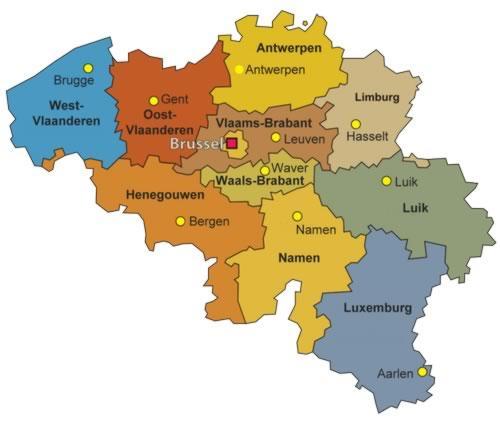 Belgium ProvincesPhoto: Kneiphof, Finn Bjørklid CC3.0 Unported no changes made
Belgium ProvincesPhoto: Kneiphof, Finn Bjørklid CC3.0 Unported no changes made
In its territory, the province has responsibility for everything that is of provincial interest, ie everything that must be done in the interest of the province and that does not fall under the general interest of the federal state, the communities and the regions, or the municipal interest.
There have been ten provinces since the last state reform. As a result of the latter state reform, the province of Brabant was abolished and replaced by the provinces of Flemish Brabant and Walloon Brabant. The territory of the Brussels-Capital Region falls outside the division into provinces.
The provinces are autonomous institutions, but are supervised by the regions and to a lesser extent by the federal state and the communities. Provinces have a provincial council and its members are elected directly for six years. This council takes decisions of a general nature and takes care of the provincial regulations.
The provincial council appoints six representatives from its members who form the Permanent Deputation. This Permanent Deputation is chaired by the governor and is in fact the daily administration of the province with various powers. The governor is appointed and deposed by the king, and is the responsibility of the Minister of the Interior.
Provinces have broad powers and, among other things, develop initiatives in education, social and cultural infrastructures and social policy. They are also concerned with the environment, roads and waterways, the economy, public works and housing. Although the provinces are autonomous, they are under the control of the communities and regions.
The Permanent Deputation issues permits, among other things, for the operation of industrial, craft, commercial and agricultural establishments that present risks or are harmful and must therefore be monitored.
The provincial governor has powers with regard to security and law enforcement.
Province capital area number of inhabitants as of 1-1-01
Antwerp Antwerp 2,867 km2 1,645,652
Hainaut Mons 3,786 km2 1,279,823
Limburg Hasselt 2,422 km2 794,785
Liège Liège 3,862 km2 1,020,042
Luxembourg Arlon 4,440 km2 248,750
Namur Namur 3,666 km2 445,824
East Flanders Ghent 2,982 km2 1,363,672
Flemish Brabant Leuven 2,106 km2 1,018,403
Walloon Brabant Wavre 1,091 km2 352,018
West Flanders Bruges 3,144 km2 1,130,040
Municipalities
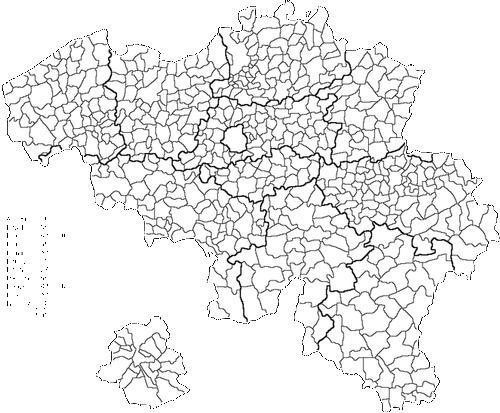 Belgium municipalitiesPhoto: Public domain
Belgium municipalitiesPhoto: Public domain
When the Belgian State was created in 1831, there were 2,739 municipalities. Since the merger of municipalities in 1975, there are still 589 municipalities:
Flanders 308 municipalities
Wallonia 262 municipalities
Brussels Region 19 municipalities
Each region supervises the municipalities of its territory. The supervision of other governments, in particular the communities and the federal state, is limited to the areas for which the communities and the federal state are competent.
In each municipality, there is a city council composed of 7 to 55 members, depending on the number of inhabitants. The municipal council arranges everything that is of "municipal interest" by means of municipal regulations. The city council elects the aldermen who, together with the mayor, form the College of Mayor and Aldermen. The mayor, under the responsibility of the Minister of the Interior, is appointed by the king from among the members of the city council. City councilors can nominate candidates to the governor.
The municipal powers are very broad and encompass everything related to the "municipal interest", which may be in the areas of public works, social assistance, law enforcement, housing, education, etc.
The municipalities are under the control of the federal state, the communities, the regions and the provinces and must also perform tasks imposed on them by the higher authorities.
The municipalities are also mainly in charge of the police forces, the management of the registry office and the maintenance of the population registers. The mayor is at the head of the municipal police. Each municipality also has a Public Center for Social Welfare that provides social assistance.
Education
General
Belgium has freedom of education under Article 24 of the Constitution. Education in Belgium is provided in institutions belonging to the official or public sector (communities, provinces, municipalities) and to the special or free sector (especially Roman Catholic schools).
The education system in Belgium is structured across the levels of primary education (pre-school education and primary education), secondary education and higher education. Moreover, the Act of 6 July 1970 included special education in the statutory regulation.
Since 1921, compulsory education applies to children aged six to fourteen. In 1983, compulsory education was extended to eighteen years, with a system of part-time compulsory education from sixteen to eighteen years.
Nursery Education
In Belgium, pre-school facilities form an integral part of the educational infrastructure. Parents, on the other hand, are free to let their children between the ages of 2.5 and 6 enjoy this education. Many nursery schools are attached to a primary school and located in the same building.
Primery Education
There is a separate free education system for each of the three official languages and communities in Belgium.
Children under compulsory school age up to the age of 15 must complete primary school and at least the first two years of secondary education. Those who do not finish the first two years of secondary education continue to attend full-time until the age of 16. One can then choose to attend part-time education until the age of 18.
Primary education is aimed at children aged 6 to 12 years, consists of six years and divided into three two-year cycles. Children become compulsory school age in September of the year in which they reach the age of six.
At the end of the six-year primary school, students receive a "Certificate of primary education" (French: Certificat d'études de base; German: CEB, Abschlusszeugnis der Grundschule).
In the Brussels Region, the study of Dutch is compulsory from the age of eight. In the rest of the French Community, a second national language (Dutch or German) or English can be taught from the age of 10.
In the German Community, French can be taught from the first grade and is compulsory from the third year.
In the Flemish Community of the Brussels Region, French can be taught from the first grade. The study of French is compulsory from the age of 8. In all other schools of the Flemish Community, French can be taught from the age of 10.
Secundary Education
Secondary education (French: enseignement secondaire; German: Sekundarschulwesen) is also compulsory and for young people aged 12 to 18. secondary education comprises four directions: general, technical, art and vocational education. The diploma of upper secondary education (French: certificat d'enseignement secondaire supérieur; German: Abschlusszeugnis der Oberstufe des Sekundarunterrichts) is awarded to students who have finished secondary education.
In the French Community, secondary education can be divided into two main categories:
Type 1, the renewed education, consisting of three two-year cycles:
First cycle: observation rate for students aged 12 to 14,
Second cycle: orientation for students aged 14 to 16,
Third cycle: degree of determination for students aged 16 to 18 years.
Type 2, traditional education, consisting of two three-year cycles.
Most students are currently attending type 1 education. For the German Community, only type 1 is available.
The offer in type 2 schools includes a smaller number of general and technical courses. The first cycle of technical education leads to a certificate of lower secondary education.
In the Flemish Community, the two types of education have been replaced by a new unitary structure comprising three two-year cycles and comprising four directions, general, technical, art and vocational education.In addition to general arts, technical and vocational education, institutions are called "atheneum" (athénée) for official (neutral) schools and "lyceum" or "college" for free schools. Institutes that provide technical or vocational education are usually referred to as "institutes".
In the French Community, the study of a foreign language is compulsory in all types of secondary education and an additional foreign language can be taught in certain directions.
In the German Community, German and French are taught from the first cycle while an additional foreign language can be taught from the second cycle. In some schools, subjects are taught in French.
In the Flemish Community, French and in some cases also English is taught from the first cycle. A foreign language is taught from the second cycle onwards and a third language is also taught in general secondary education.
Higher Education
Leuven UniversityPhoto: Juhanson CC 3.0 Unported no changes made
There are three types of higher education in the Flemish and French Community: higher education of the short type, of the long type and university education.
University education is provided at universities or university-level institutions and comprises courses of at least four years divided over two cycles. Each cycle is concluded with a diploma that grants access to the next cycle. Each of these cycles runs over two to three years.
Short-type higher education consists of one cycle of three to four years and covers a wide range of courses of study.
Long-type higher education is equated with university education and comprises two cycles that run for at least four years.
In addition to the six "full" universities, there are a number of university institutions that offer a limited number of courses of study.
In the German Community there is only higher education of the short type. Allied and pedagogical higher education concludes with the "Graduierte" diploma.
The following university diplomas are awarded in the French Community:
-candidate after the first two- or three-year cycle.
-licencié after the two- or three-year second cycle.
-doctor.
Short-type higher education is concluded with a graduate diploma.
In the Flemish Community, the first cycle of university education is concluded with the candidate diploma. The second cycle concludes with the licentiate diploma and the third cycle concerns the doctorate.
Politics
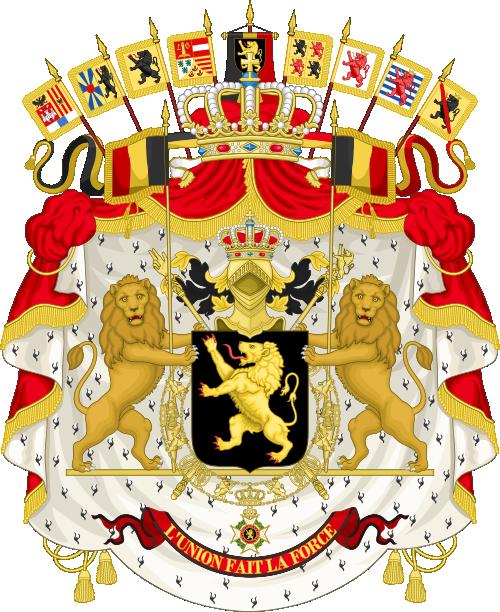 Coat of arms of BelgiumPhoto: Sodacan CC 3.0 Unported no changes made
Coat of arms of BelgiumPhoto: Sodacan CC 3.0 Unported no changes made
Belgian domestic politics has been dominated since long time by three political groups: the Christian Democrats, the socialists and the liberals, who rule Belgium in varying coalitions. Since the seventies of the 20th century, these three groups have been divided into regional Flemish and Walloon parties.
The parliamentary elections of July 1999 caused a major shift in the Belgian political landscape. This was mainly due to many scandals in the 1990s, including the murder of Deputy Prime Minister André Cools, the Dutroux affair, the Augusta-Dassault bribery scandal and the contamination of animal feed with dioxin. Major election winners were the Greens and Liberals who, together with the Socialists, formed a government led by Guy Verhofstadt. For the first time since 1958, the Christian Democrats entered the opposition.
The far-right Vlaams Blok is nowadays a significant factor in both Belgian national and local politics. In 1995, the Vlaams Blok was the largest party in Antwerp with 27% of the votes. The current political situation is described in the chapter on history.
Sources
Belgium, a way of life
Lannoo
European Union: fifteen country documents
European Platform for Dutch Education
The Stateman's Yearbook: the politics, cultures and economies of the world
Macmillan Press Limited
CIA - World Factbook
BBC - Country Profiles
Last updated December 2025Copyright: Team The World of Info
